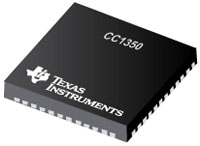By Texas Instruments 30

Texas Instruments' CC1350 is a member of the CC26xx and CC13xx family of cost-effective, ultra-low-power, 2.4 GHz and sub-1 GHz RF devices. Very-low active RF and microcontroller (MCU) current consumption, in addition to flexible low-power modes, provide excellent battery lifetime and allow long-range operation on small coin-cell batteries and in energy-harvesting applications.
The CC1350 is the first device in the CC13xx and CC26xx family of cost-effective, ultra-low-power wireless MCUs capable of handling both sub-1 GHz and 2.4 GHz RF frequencies. The CC1350 device combines a flexible, very-low-power RF transceiver with a powerful, 48 MHz, Cortex-M3 microcontroller in a platform supporting multiple physical layers and RF standards. A dedicated radio controller (Cortex-M0) handles low-level RF protocol commands that are stored in ROM or RAM, thus ensuring ultra-low power and flexibility to handle both sub-1 GHz protocols and 2.4 GHz protocols (for example Bluetooth low energy). This enables the combination of a sub-1 GHz communication solution that offers the best possible RF range together with a Bluetooth low energy smartphone connection that enables great user experience through a phone application. The sub-1-GHz-only device in this family is the CC1310.
The CC1350 device is a highly integrated, true, single-chip solution incorporating a complete RF system and an on-chip DC-DC converter.
Sensors can be handled in a very low-power manner by a dedicated, autonomous, ultra-low-power MCU that can be configured to handle analog and digital sensors; thus the main MCU (Cortex-M3) can maximize sleep time.
The CC1350 power and clock management and radio systems require specific configuration and handling by software to operate correctly, which has been implemented in the TI-RTOS. TI recommends using this software framework for all application development on the device. The complete TI-RTOS and device drivers are offered in source code free of charge.
TI Design Link: Motor Monitoring Using Wireless Vibration Sensor Reference Design Enabling Preventive Maintenance
| Features | ||
|
|
Video: Embedded World 2017: Digi-Key Development Kits – Texas Instruments SimpleLink CC3220 + CC1350 Launch